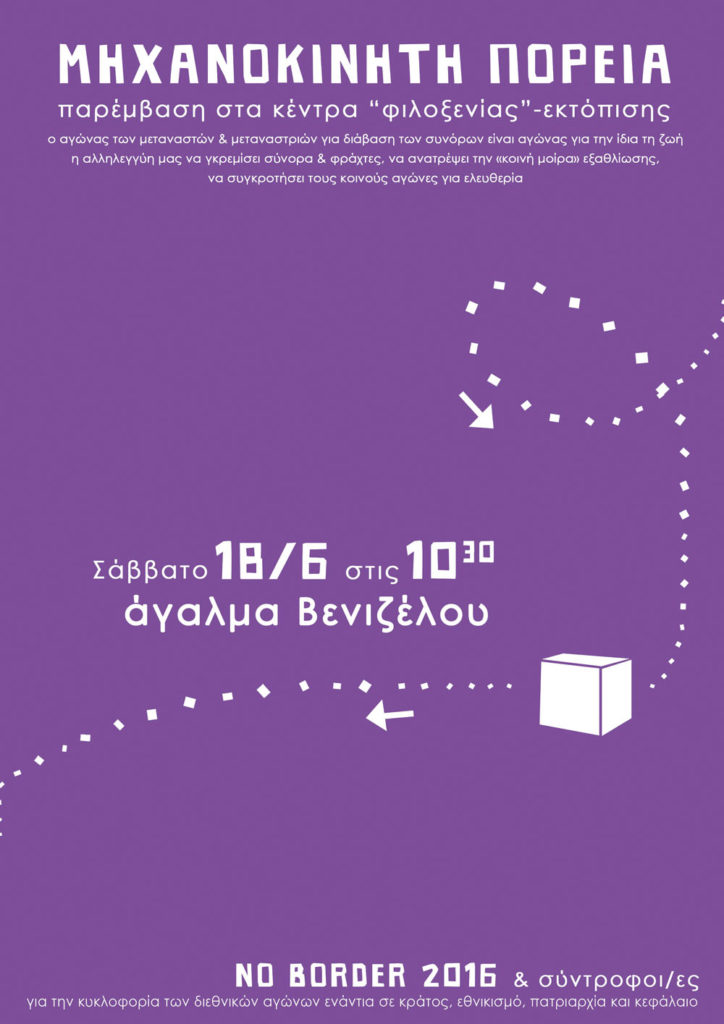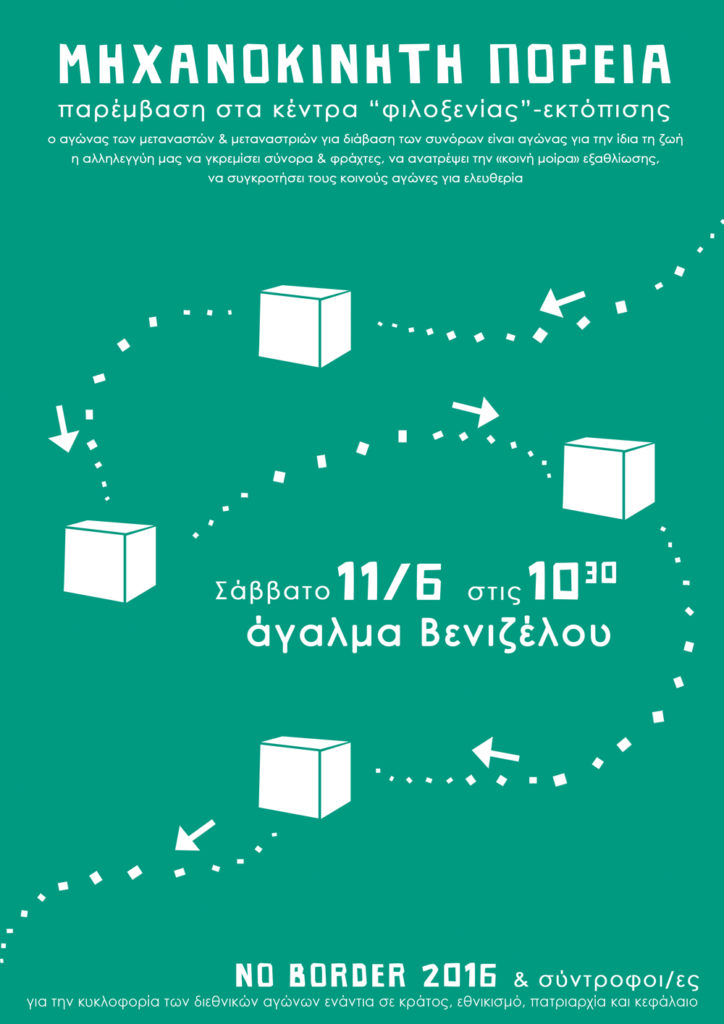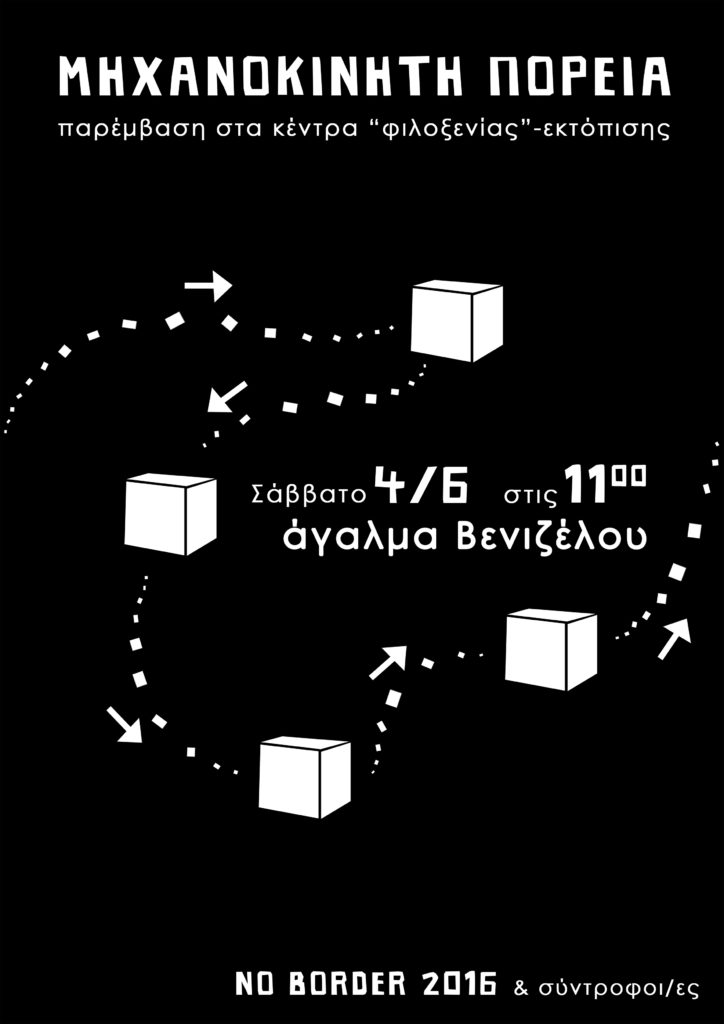Changing Escape Routes: Alarm Phone experiences in the Mediterranean Sea
Alarm Phone Five-Week Report, 25th April to 29th May 2016
For most of the past five weeks, the Alarm Phone remained largely silent. Whereas a few weeks ago we received dozens of calls from the Aegean region per week, sometimes even per day, the new deterrence measures between Greece and Turkey have resulted in fewer attempted sea crossings and the Alarm Phone was not involved in any emergency situations in this region. In the Western Mediterranean Sea, the Alarm Phone was involved in three instances of successful sea-crossings from Morocco to Spain. In the five weeks that this report covers, we witnessed a remarkable increase of crossings from Libya to Italy and were alerted to 7 cases of boats in distress at sea in the Central Mediterranean. For the first time in months, Syrians and Iraqis were amongst these cross-border travellers trying to reach Italy and in several harrowing shipwrecks hundreds of people lost their lives.
While European politicians and institutions regard the decrease in border crossings in the Aegean Sea as well as the violent expulsions of migrants and refugees back to Turkey a success, it is clear that border violence has merely been displaced, further externalised, and thereby increasingly invisibilised. On the one hand, the Turkish government, its police, military and coastguard forces now enact European border control by deterring people from escaping and by disallowing those exposed to the cruelty of the Syrian war to enter Turkey. This, as we had to witness, has direct and deadly consequences. Unable to flee Syria, dozens of refugees were murdered in a refugee camp in Northern Syria through air strikes, presumably launched by the Syrian dictatorial regime (http://www.bbc.com/news/world-middle-east-36214290). On the other hand, these deterrence measures have led to yet another shift of migration routes, forcing Syrians and others to move to war-torn Libya and onto the perilous sea journey to Italy. In the past weeks, the numbers of people trying to reach Italy have increased steadily, with more than 13.000 people arriving in the last week alone (http://www.bbc.com/news/world-europe-36408029). In several shipwrecks, more than 1.100 travellers have drowned in May (https://missingmigrants.iom.int/mediterranean).
Last week, on three consecutive days, boats with hundreds of travellers on board capsized north of the Libyan coast. On Thursday the 26th of May, the Alarm Phone was directly called from one of these boats and witnessed the capsizing of a boat with presumably more than 500 travellers on board. When the survivors reached Italy and were interviewed, they stated how their vessel was towing a second vessel that then capsized after no rescue was in sight for several hours. Some people of the sinking boat seemed to have been able to swim to the first boat and survive. Others were able to stay alive until rescue services arrived. However, many more seem to have lost their lives (http://www.bbc.com/news/world-europe-36408029).
We have already published several statements on this incident, which clearly showed the fatal consequences both of the EU-Turkey deal and of the unwillingness to provide sufficient rescue capabilities in the Central Mediterranean Sea:
https://alarmphone.org/en/2016/05/26/statement-boat-with-500-syrian-and-iraqi-refugees-sank-about-70-km-north-east-of-zuwara-libya/
https://alarmphone.org/en/2016/05/27/statement-in-light-of-the-current-situation-in-the-mediterranean-sea/
Although the need for expanded rescue operations is obvious, European and other Western governments are instead reinforcing their deterrence regime in Northern Africa and in the Central Mediterranean Sea, for example by expanding Eunavfor Med and NATO operations into Libyan territorial waters – without efficiently using these assets for rescue operations – and through intensified collaboration with the Libyan ‘unity government’ (http://www.france24.com/en/20160425-italy-says-nato-three-months-libya-coast-mission). While they employ humanitarian rhetoric to justify these measures, supposedly part of a war on human smuggling, they either further prevent people from fleeing, in fact arresting them in places where they continue to face severe human rights violations, or refrain from rescuing them in cases of distress at sea.
Until European navies, NATO, Frontex vessels and coastguards can officially enter Libyan waters to push people back to Libya, they seem to employ their assets only for selective and media-effective rescue operations. On the 30th of April, a boat left from Sabratah/Libya with about 100 people on board. About 7 nautical miles off the coast, they entered into a situation of distress (http://ffm-online.org/2016/04/30/libyen-italien-mind-70-boat-people-ertrunken/). None of the European military assets were nearby. Only a cargo vessel was in the vicinity and when it arrived at the scene of distress, at least 70 people had already drowned. This shipwreck, one amongst uncountable others, was completely silenced in the mainstream media. Migrant deaths at sea have become so normalised and routine that the deaths of dozens of people trying to find freedom and escape violence does not even make the news anymore. Only when several hundred people drown, they make the headlines.
Even those people who have made it to Europe, are not safe: tens of thousands are still stuck in Greece as the neighbouring countries keep their borders closed. Moreover, those who have arrived in Greece after the 20th of March 2016 face the threat of being deported back to Turkey under the EU-Turkey readmission deal. In several camps across Greece, refugees have protested against the appalling living conditions, against the EU-Turkey readmission agreement, and for the right to continue the journey to Europe.
On the 24th of May, Greek police forces began to forcefully mass-evict refugees from the large Idomeni camp by the Greek-Macedonian border. Over several days, those who had been stuck in Greece for a long time and who had protested uncountable times right in front of the borders to Macedonia were removed from the camp. Now the Idomeni camp is officially closed and its former inhabitants were brought to military camps which, according to our allies from Moving-Europe (http://moving-europe.org/) do in no way fulfil minimum standards: adequate supply of food is not given, sleeping places are rare as is medical care, and having access to asylum procedures and registration remains for most people impossible. Moving-Europe and Medico International (https://www.medico.de/kritik-an-raeumung-idomeni-16440/). have denounced the eviction. It is clear that it offers no solution but only displaces and invisibilises the plight of thousands of refugees.
It is high time for the public to join these struggles of refugees, and to confront and protest Europe’s deadly policies of deterrence. In the days to come, and as we have seen after every previous large-scale sea tragedy, EU politicians and institutions will publicly express their sorrow about the many fatalities. They will call for policy-changes and the further militarisation of the sea. They will again blame the smugglers and seek to reinforce deals with authoritarian regime. However, every shipwreck and every death of the past years is a consequence of exactly these European actions and inactions. Not the smugglers are to blame. While they often cynically contribute to the unbearable suffering of migrants and refugees, they simply profit from the illegality industry that Europe maintains and keeps subsidising. We will continue with our struggle to counter Europe’s policies of deterrence, leaving-to-die and abandonment: Ferries not Frontex!
Summary of Alarm Phone cases
In the past 5 weeks, the Alarm Phone was alerted to 10 emergency situations, of which 3 occurred in the Western Mediterranean Sea and 7 in the Central Mediterranean Sea. Summaries and links to the individual reports can be found below.
Western Mediterranean Sea
On Friday the 6th of May 2016, at 11.08am, the Alarm Phone was alerted to a boat in distress on the way from Morocco to Almería with about 34 persons on board, including 3 children and 10 women. We could not establish direct contact with the travellers, as the phone connection did not work, even though we had two contact numbers from people on the boat. We contacted the Spanish maritime rescue agency Salvamento Maritimo (S.M.) in Almería about the case. At 6pm S.M. informed us that they had found the boat one hour earlier about 17 miles off the Spanish island of Alborán, mid-way between Morocco and Spain. On Saturday, at 11.20am, we came across a message of S.M. on Twitter stating that they had rescued 37 persons from a boat East of Alborán and that they had transferred them to Almería. A local newspaper in Almería also mentioned the case and the successful rescue operation. See: http://watchthemed.net/reports/view/510.
On Saturday the 7th of May 2016, at 4.12pm, the Alarm Phone was alerted to a boat, carrying 35 persons, including 10 children and 6 women, who had left from Al Hoceima in the direction ofAlmería. We could not establish a direct connection with the boat, but informed the Spanish rescue agency Salvamento Maritimo about the case at 4.30 pm. They told us that they were searching for another boat with 44 travellers about 10 miles from coast of Melilla. At 5.30pm, we called Salvamento Maritimo again. They told us about one boat with about 50 persons who had been rescued by the Moroccans navy, but they assumed that another boat was in the area, so they continued the search with a helicopter. At 6.50pm Salvamento Maritimo informed us that the helicopter had spotted a boat with about 30-40 persons and that a rescue boat was underway. At 9.25pm, Salvamento Maritimo confirmed to us that a boat with 35 persons had been rescued and brought to Almería. See: http://watchthemed.net/reports/view/511.
On Saturday the 28th of May 2016, at 7.27am, the Alarm Phone was directly called from a boat that had left from Tangier/Morocco 3 hours earlier. There were 11 travellers on board, amongst them one child. They asked us to call the Spanish rescue organization Salvamento Marítimo, but as they were not in immediate distress, we agreed that they would continue their journey and call us back later. 30 minutes later, we talked again to the travellers. They were still rather calm and told us that they had continued their journey. At 9am, we decided to alert the Spanish rescue organization Salvamento Marítimo (S.M.). We called their office in Tarifa/Spain and forwarded all the information we had. We were told that S.M. had just started a rescue operation in the region, probably of the boat that had called us. At 9.11am, we called the travellers again and they confirmed to us that they had been rescued by S.M. We forwarded a link to the Welcome to Europe guide for Spain to them. See: http://watchthemed.net/reports/view/515.
Central Mediterranean Sea
On Wednesday the 4th of May 2016, we were alerted to one distress case in the Central Mediterranean Sea. At 7.14am, Father Mussie Zerai sent us an e-mail about a boat, carrying about 430 persons. They were in distress, because of a strongly agitated sea. They had left from Zuwara, Libya at about 6 pm local time. Father Zerai had already contacted the Italian Coastguard about the case, but their answer was that there were no military ships in the area and that a rescue operation would be difficult given the high waves. They suggested that the migrants return to Libya. At 8am we called the Coastguard of Malta. They knew about the case, but told us to ask the Italian Coastguard. We could not reach the travellers, but called the Italian Coastguard again. This time, they told us that they had launched a rescue operation. At 12.32 the Italian Coastguard confirmed to us that they had rescued all 430 persons to Italy. See:http://watchthemed.net/reports/view/508.
On Thursday the 5th of May 2016, at 5am, Father Mussie Zerai alerted the Alarm Phone to a rubber-boat in distress with 150 person on board. The boat had started the day before between 8 and 9pm from Libya, near Sabratah. We checked and later uploaded the credit of the travellers’ satellite phone. At 7.28am we could establish a direct contact with the travellers: They explained that their rubber-boat was leaking. They could not give us an exact GPS-position, because their phone was in Arabic and none of the travellers could read Arabic. We informed the Italian and the Maltese Coastguards about the case. At 7.28am in a call with the Italian Coastguard, the officer on duty asserted that the boat in distress had already been detected and that a warship was underway to carry out the rescue operation. At 12pm the Italian Coastguard told us that the boat had very probably been rescued. They emphasized that they were working on several cases of distress in the area. This was later confirmed by media reports. An article on Friday stated that many boats had left Libya the day before and that about 1800 people were rescued within 24 hours. See: http://watchthemed.net/reports/view/509.
On Monday the 16th of May, at 9.33am, Father Mussie Zerai informed our shift team about two boats in distress in the Central Mediterranean Sea. Boat 1 carried about 150 people, including pregnant women and children on a rubber boat that had left from Sabratah/Libya and boat 2 carried about 65 people, including one pregnant and sick woman on a rubber boat that had left from Tripoli. While we had their satellite phone numbers and tried repeatedly to contact them, we were unable to reach them. Shortly afterwards, we informed the Maritime Rescue Coordination Centre (MRCC) Rome as well as the Rescue Coordination Centre (RCC) Malta about both boats. They took note of the information and confirmed that they would engage. We continued to call both boats but were unable to get through. At 4.15pm, MRCC Rome informed us that boat 1 had been rescued by Dignity I, the humanitarian vessel operated by Doctors without Borders. They also stated that the rescue of boat 2 was very likely as there were 3 rescuers in the area, as well as an airplane that was scanning the water. See:http://watchthemed.net/reports/view/513.
On Tuesday the 17th of May 2016, at 11.35am, our shift team was called by a contact person who passed on the phone number of a group of 191 Syrians who were on a boat that had left from Libya about 5 hours earlier and were moving toward Malta. The phone was not reachable anymore and the contact person also did not have information about the location of their departure. Our shift team then tried to call the boat but without success. We checked their phone credit online and they had sufficient credit to make calls. At 12.40pm, we contacted the Maritime Rescue Coordination Centre in Rome and informed them about the case. At 2.46pm MRCC Rome confirmed that they were working on the case. Later in the afternoon, the Italian coastguards tweeted about the rescue of 200 people, including 45 women and 11 children. At 5.45pm we contacted MRCC Rome and they confirmed the rescue of the boat in question. See:http://watchthemed.net/reports/view/512.
On Thursday the 26th of May 2016, at 5.25am, the Alarm Phone was directly called from a boat in distress between Libya and Italy, which was accompanied by another boat, each carrying 500 people. We alerted the Italian Maritime Rescue Coordination Centre (MRCC) at 6.10am and passed on the number of the travellers’ satellite phone. At 6.21am, we received their GPS coordinates and immediately forwarded them to the MRCC. In the following hours, we stayed in contact with both, the travellers in distress and several involved coastguard agencies, private shipping companies and civilian rescue organizations. We regularly forwarded updated coordinates and observed that several rescue vessels were approaching the location of distress.At 7.10am, we learned from the travellers that they had met a third boat, with 35 people on board. At 8.45am, the travellers called us again and told us that one of the boats just sank, that 500 people went overboard and many of them had already drowned. At 10.30am, we were able to talk to the travellers again, who told us that an Italian commercial vessel had rescued the travellers on the small boat, about 30 people. In the following hours, we were not able to reach the travellers again. However, we continued to observe the ongoing rescue operation and tried to get updates from the Italian and Maltese coastguard and from private rescue organizations like SEA-WATCH. In the afternoon, at 5.50pm, the MRCC Rome told us that the boats we had been in contact with, had been rescued. But we still feared that this information only included the first big boat (with a satellite phone on board) and the very small one. It remained an open question, what happened to all the people on the second big boat, after it obviously sank. Although MRCC did not mention any fatalities in their daily statement, we know about many deaths by other sources. In contact with SEA WATCH we learned that they recovered several bodies very close to the GPS location of the estimated accident. On the following days, we received the sad confirmation by survivors of this shipwreck, that probably more than 400 people drowned and disappeared with the second boat and that only about 100 people were able to swim to the other boats or had been rescued after the boat sank. See:http://watchthemed.net/reports/view/514.
On Saturday the 28th of May 2016, at 10pm, a contact person informed the Alarm Phone about a boat in distress 60 miles south of the Italian island of Pantelleria, with about 12 people on board. We called the Italian coastguard at 10.20pm and forwarded the GPS position of the boat in distress. We were told that the coastguard was already performing a rescue operation in this area, with respect to a boat with 40 people on board. At 11.25pm, the contact person called us again and informed us that the boat had safely arrived on the Italian island of Pantelleria. We forwarded this information to the Italian coastguard, who was still searching for the boat, and also provided them with the phone number of the contact person. See:http://watchthemed.net/reports/view/516.
Alarm Phone 5 Week Report, 25 April to 29 May 2016





